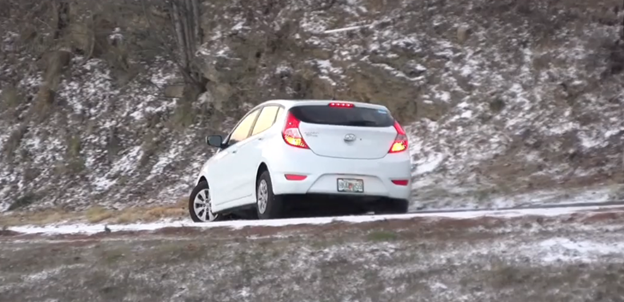Lesson Five: Inclement Weather Conditions (7.5)
Inclement weather is abnormal and/or severe weather conditions. Any type of weather condition, even glaring sunlight, can increase your risk as a driver. Most of your decisions are based on what you see. All inclement weather conditions reduce your visibility and require a speed reduction. Others can affect your traction, stopping distance, handling, tracking, and/or a combination of all.

 Inclement Weather
Inclement Weather
Using your worksheet, identify the following inclement weather conditions from the video and what actions you should take to reduce your risk
There are several ways to reduce risk in these conditions.

- Check road conditions on your route before you go at TripCheck or by dialing 511. You may need extra time.
- Speed reduction is usually your first response.
- When driving in these conditions, brake and accelerate gradually.
- Keep a minimum of 6 seconds following distance; increase distance if conditions worsen.
Do not use cruise control during inclement weather. Cruise control attempts to maintain a constant rate of speed for the vehicle. You must be able to re-adjust your speed for changing roadway conditions.
There are other tools you can use depending on the weather conditions. Know your skill level, the vehicle’s limitations, condition, and any advanced vehicle technology. Maintain emergency supplies in your vehicle to ensure that you are prepared for inclement weather driving and any unexpected situation.
 Skids
Skids
Skids
Traction is created when the tire grips the surface of the road. The greater the contact, the better the traction. During inclement weather, that contact is compromised. Ice, snow, and water reduce the ability of tire to make contact with the road.

When your vehicle loses traction, a skid occurs. The contributing factors of vehicle skids can be divided into three groups.
-
_______________________________
-
_______________________________
-
_______________________________
It is easier to prevent a skid than it is to correct one. To avoid a skid, reduce your speed, look to target, and perform all actions smoothly and gradually. If a skid does occur, take your foot off the pedals, and steer into the target.
Essential Questions
-
What are the risks associated with driving in inclement weather?
-
How do you apply SIM while driving in inclement weather?
Friction or gripping power between the tire patches and the roadway surface. The grip between the tires and the road surface that allows a vehicle to start, stop, and/or change direction.